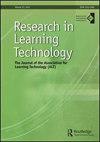Content-specific differences in Padlet perception for collaborative learning amongst undergraduate students
IF 1.2
Q2 EDUCATION & EDUCATIONAL RESEARCH
引用次数: 15
Abstract
Collaborative learning offers benefits but there is insufficient information on how students perceive specific digital tools supporting collaborative learning and whether there are content-related differences in students’ perceptions. Here, we utilised Padlet to mediate collaborative learning amongst undergraduate students from two distinct disciplines, Dentistry and Bioscience to examine students’ perceptions of Padlet-mediated learning and identify any content-specific differences. Data distribution was assessed via Shapiro–Wilk test, Mann–Whitney U test was used to assess distribution of responses and correlations were studied via Spearman’s rank correlation coefficient (ρ). Data revealed that majority of students across both cohorts perceived Padlet as easy to use and beneficial to learning. Dentistry students perceived Padlet to be more beneficial to learning and easier to use than Bioscience students (p < 0.01). Most Bioscience students liked to undertake collaborative learning via Padlet, whereas most Dentistry students felt more confident to ask questions and better understood content via Padlet. In the Bioscience cohort, perceived benefit-to-learning strongly correlated (ρ = 0.75; p < 0.01) with fondness to use Padlet, whereas in the Dentistry cohort, it moderately correlated (ρ = 0.5; p < 0.01) with better understanding of subject content. Thematic analysis of students’ textual responses revealed anonymity, peer-learning and engagement as key benefits. Thus, this study strengthened the evidence for using Padlet for collaborative learning in a wider context. Moreover, it uncovered significant disparities in students’ perceptions of the tool, when used to foster learning of different subject contents.大学生协作学习中小块感知的内容差异
协作学习提供了好处,但关于学生如何感知支持协作学习的特定数字工具以及学生感知中是否存在与内容相关的差异的信息不足。在本研究中,我们利用小纸片来调节来自两个不同学科的本科生之间的协作学习,牙科和生物科学,以检验学生对小纸片介导学习的看法,并确定任何特定内容的差异。采用Shapiro-Wilk检验评估数据分布,Mann-Whitney U检验评估反应分布,并采用Spearman等级相关系数(ρ)研究相关性。数据显示,两组学生中的大多数人都认为Padlet易于使用,有利于学习。牙科专业学生认为Padlet比生物科学专业学生更有利于学习和更容易使用(p < 0.01)。大多数生物科学学生喜欢通过Padlet进行协作学习,而大多数牙科学生则更有信心通过Padlet提出问题并更好地理解内容。在生物科学队列中,感知到的收益与学习强相关(ρ = 0.75;p < 0.01)与偏好使用Padlet相关,而在牙科队列中,中等相关(ρ = 0.5;P < 0.01),对学科内容的理解程度较高。对学生文本回复的专题分析显示,匿名、同侪学习和参与是主要的好处。因此,本研究加强了在更广泛的背景下使用小板进行协作学习的证据。此外,它揭示了学生对该工具的看法的显著差异,当用于促进不同学科内容的学习时。
本文章由计算机程序翻译,如有差异,请以英文原文为准。
求助全文
约1分钟内获得全文
求助全文
来源期刊

Research in Learning Technology
EDUCATION & EDUCATIONAL RESEARCH-
CiteScore
6.50
自引率
0.00%
发文量
13
审稿时长
20 weeks
 求助内容:
求助内容: 应助结果提醒方式:
应助结果提醒方式:


